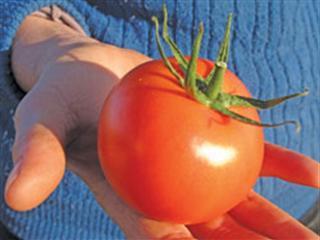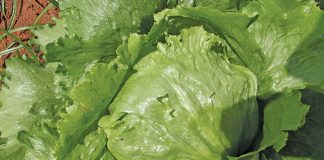Notwithstanding its name, PVY attacks peppers, tobacco, tomatoes as well as potatoes. It is spread mainly by aphids.
Symptoms include vein clearing and yellow patches on the leaves, which tend to become puckered. Yield is drastically reduced. A number of common broadleaf weeds also host PVY. For this reason, you should always remove weeds from the verges of crops vulnerable to viruses.
It’s also good practice to inspect the condition of weeds further away from the land. If some plants have mottled, distorted leaves and are yellowed, while others of the same species close by are healthy, this can be a sign of PVY. Use herbicide to prevent it spreading. Many aphid species transmit PVY through feeding as the virus particles adhere to their mouthparts.
However, the number of virus particles decreases after every feed on an uninfected plant. With this in mind, it’s easier to work out a control strategy if you know that PVY is in the district. If the plants are kept free of aphids, the spread of the virus in the land will be drastically slowed. That said, transmission can also be via pruning shears, hand pruning and sap. If your own land is clear of aphids, the source of infection will be aphids from outside the land. This is why it’s wise to clear the areas around lands.
How to control pvy
Aphids usually probe several species before finding a crop to their liking. Each probe will reduce the threat of transmission.
If the precautions mentioned are taken, the chance of infection through aphids becomes very slight. Unfortunately, few farmers take these precautions and only react when there’s an outbreak, by which time it’s too late. As with other viruses, you should inspect the crop often and remove infected plants. With PVY, a newly infected plant may display symptoms only after a few weeks. The good news is these plants will not infect others as long as there is no aphid activity. Although certain capsicum varieties are resistant to the virus, some PVY strains can overcome this resistance. Nonetheless, where the virus is prevalent, it is better to use a resistant variety.
Cucumber mosaic virus
Like PVY, cucumber mosaic virus (CMV) is transmitted by aphids and is not seed-borne. Several aphid species serve as vectors, while there are a number of hosts, including some common weeds, that can act as reservoirs for the virus. CMV can be passed on after only a minute of feeding, but the aphids do not remain infectious for long. For this reason, you should ensure, as with PVY, that aphids do not multiply on the land.
Among the first symptoms you will see are plants of a lighter colour, and narrowed leaves with vein clearing. Growth may be compact, much like bunchy top virus in tomatoes. There are fewer resistant varieties in the case of CMV than with PVY, so good farming practices become even more important. In fact, there is no reason – barring a neighbour with an infected crop – for either of these diseases to gain a foothold in your crop if you take the precautions discussed.
You can, however, reduce the likelihood of getting either CMV and PVY from outside the land by planting barrier crops between capsicum lands. A maize crop, which grows tall, is especially effective. If you intend to plant such crops anyway, it makes sense to exploit this option.













